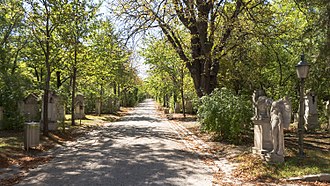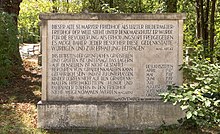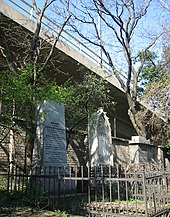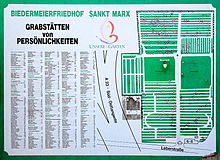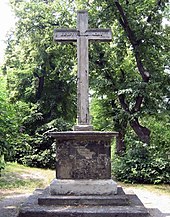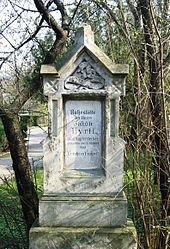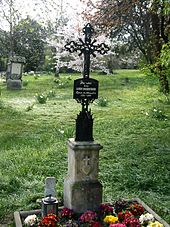Sankt Marxer Friedhof
The Sankt Marxer Friedhof is a cemetery in the 3rd district of Vienna, Landstrasse , which was closed in 1874 and is now a listed building. Probably the most famous grave in this cemetery is that of the composer Wolfgang Amadeus Mozart . The City of Vienna runs the Sankt Marxer Friedhof as a public park.
history
The reforms of Emperor Joseph II.
Efforts had been made in Vienna to ban the cemeteries from the city center as early as the 16th century. However, reforms were particularly difficult to implement with regard to burials in Vienna, as the Viennese population had a firmly established opinion of how a funeral and the associated festivities should be organized and did not intend to give up their traditional customs. It was not until the end of the 18th century that Emperor Joseph II enforced the closure of the cemeteries in the urban area and in the suburbs with an epidemic and hygiene ordinance issued in the course of his Josephine reforms , and also forbade burials in the church tombs and monasteries within the line wall . Excluded from this were burials in the Capuchin Crypt , St. Stephen's Crypt and the Salesian Monastery .
Instead, five so-called communale cemeteries were laid out in 1784 outside the line wall , today also known as Biedermeier cemeteries . This is how the Sankt Marxer Friedhof, the Hundsturmer Friedhof , the Matzleinsdorfer Friedhof , the Währinger Friedhof and instead of the one originally planned in Brigittenau the Schmelzer Friedhof came into being . Due to this ordinance, the Jewish community of Vienna also had to build the Jewish cemetery in Währing outside the lines as a replacement for their cemetery in Roßau . In contrast to the Catholic suburban cemeteries, the latter was not abandoned, as the graves in Jewish cemeteries exist "for ever" and no exhumations or transfers of the dead may be carried out.
Development of the Sankt Marxer Friedhof

The St. Marx Cemetery was outside the line Walls near the line office St. Marxer line built. Sankt Marx was part of the suburb of Landstrasse , the name can be traced back to a chapel of the citizens' hospital located there, which was consecrated to St. Mark (St. Marks) .
With the opening of the Sankt Marxer Friedhof, several smaller suburban cemeteries were abandoned and the bones were moved to the new cemetery, so the remains of those buried in the Landstraßer St. Nikolai cemetery (where the Rochusmarkt is today) were also transferred here among others those of the sculptor Georg Raphael Donner . The Sankt Marxer Friedhof was first mentioned by name on May 17, 1784 in a death register ( parish of Mary's birth ), but it is probable that burials took place here in the weeks before. The cemetery was responsible for parts of the inner city , the suburbs of Landstrasse, Erdberg and Weißgerber as well as today's Leopoldstadt .
At the time of its opening, the cemetery was still far outside the city, but from 1850 onwards - after the defensive structures had been razed, the Vienna suburbs incorporated and the line wall removed - it quickly advanced to the cemetery. As contemporary sources and ordinances show, the communal cemeteries under the Josephinian reforms also had the purpose of keeping the dead as far away from the living as possible. In the first few years it was even forbidden to accompany the hearse on their way to the cemetery beyond the city wall or to mark graves. An exception were graves that were located directly on the cemetery wall, which is why the oldest graves with tombstones are there. Only when the ban was lifted because the resistance of the clergy and the citizens was too strong, simple graves were also allowed to be equipped with gravestones.
After the construction of the Wiener Neustädter Canal , opened in 1803, the cemetery was now on the southwest bank of this watercourse and was thus separated from Sankt Marx and the arterial road (today's Rennweg ). In front of the St. Marxer Linientor a bridge was built over the canal, over which the cemetery could still be reached. On October 26, 1848, fighting took place in the cemetery during the October Uprising in Vienna , during which the Viennese defenders were able to push back Croatian units. But just two days later the St. Marx Line fell , and on October 31st the military stormed the inner city.
Closure and conversion into a park
From the middle of the 19th century, due to the population explosion in Vienna, the communal cemeteries quickly became too small, which is why the city fathers decided to build the Vienna Central Cemetery , which was finally opened on November 1, 1874. At the same time, the five communal cemeteries were closed after 90 years of existence. At that time, the Sankt Marxer Friedhof had - after several extensions - an area of over 60,000 m² and was thus the second largest of the communal cemeteries after the Schmelzer Friedhof . Occasionally, however, burials were still carried out here after 1874, especially in existing family tombs, for example the Prater entrepreneur Basilio Calafati was buried in 1878. In the 1880s, the exhumation of prominent deceased from the Sankt Marxer Friedhof and relocated to the central cemetery began, as honor grave groups were created there to increase the attractiveness of the new “city of the dead” .
The Sankt Marxer Friedhof was subsequently left to its own devices, which led to the area becoming overgrown. According to a decision by the Vienna City Council on February 10, 1922, the five former communal cemeteries were to be abandoned and converted into parks. In the years that followed, the Hundsturm cemetery became the Haydn Park, the Matzleinsdorfer cemetery became the Waldmüller park, the Währinger cemetery became the Währinger park , and the March park was built on part of the Schmelzer cemetery area . The local history researcher Hans Pemmer campaigned for the preservation of the Sankt Marxer Friedhof so that it was placed under monument protection and was the only one of these five cemeteries to remain. After a renovation and repair of the entire cemetery under the direction of the architect Anton Waldhauser, it was handed over to the Viennese population as a public park on October 22, 1937 and in 1943 placed under the care and maintenance of the City Garden Authority.
In 1945, during the Battle of Vienna , the cemetery was the scene of fighting between the Red Army and an SS unit, and parts of the area were badly damaged by bombs in the preceding months. Soon after the end of the war, with the help of Hans Pemmer, the restoration of the facility began, so that the cemetery was open to the public again from August 3, 1946. In the years after the Second World War, the Vienna Cultural Office had memorial stones and tombs erected for prominent deceased, for example if they were transferred to honorary graves in the central cemetery or buried in shaft graves. This affected, among others, the grave sites of Alois Negrelli von Moldelbe , Moritz Daffinger , Karl Agricola , Johann Georg Albrechtsberger and Joseph Drechsler .
In November 1957, the Vienna City Building Authority planned an extension of the Landstraßer belt , the route was originally supposed to run north of the cemetery. Therefore, in 1958, the cemetery in the area of the northern corner to the right of the entrance was reduced by around 1,500 m², and four historically important graves had to be moved a few meters ( Louis Montoyer , Jakob Hyrtl, Karl Krottenthaler and Johann Nepomuk Höfel ). The mausoleum of the brick industrialist Heinrich von Drasche-Wartinberg , which was never used for burials, was classified by the responsible art historians as not worthy of preservation. When these adjustments had already been carried out, the city building authority changed its plans to the effect that the connection between the belt and the projected “Autobahn connection Vienna South” should now run south of the cemetery. The area freed up in the north of the facility was instead used for municipal housing. Between Hofmannsthalgasse and the newly drawn northern boundary of the cemetery, a community building, completed in 1959, was erected; an associated green area including a children's playground now extends to the cemetery wall.
Only many years later did the construction of the A23 motorway and its connection to the Landstraßer Gürtel necessitate a further downsizing of the cemetery area, but this time only by a few square meters in the southern corner of the complex. Here three historically relevant graves have been moved a few meters, including that of the industrialist Karl Klinkosch. Since the opening of this section of the motorway in the 1970s , the city motorway, which is designed as an elevated road in this area , and its exit to the Gürtel have been nestled in a curve close to the south and east side of the Sankt Marxer Friedhof.
In 1996, a garden monument preservation concept was drawn up on behalf of the Federal Monuments Office . Among other things, a sample restoration of two typical tombs was carried out in cooperation with the Vienna Cultural Office . An analysis of the stone material showed that fine-grained Leitha limestone from Stotzing was used for the steles and the medallion of the larger tombstone , while the inscription plates were made from Solnhofer limestone slates and the bases and tops were made from coarse-grained Leitha limestone from St. Margarethen and Kaisersteinbruch .
In August 2005, the City of Vienna decided on a comprehensive package of measures to further preserve the cemetery. The main focus was on the repair of the tombstones, as they are largely made of sandstone and are not in good condition. Tombs made of comparatively weather-resistant materials such as marble or granite were rarely made at the time. On behalf of the cultural office, all grave sites and their state of preservation were recorded in a database. Now, as part of a multi-year project supported by the Vienna Old Town Conservation Fund, damaged and weathered tombstones are to be restored.
The cemetery today
The Sankt Marxer Friedhof is located in the south of Vienna's 3rd district, Landstrasse . It is surrounded by an exposed brick wall, the south-eastern side of which forms the border with the 11th Simmering district. The cemetery has an almost rectangular shape and an area of around 60,000 m². Originally there were more than 8,000 graves here, of which 5,635 are still preserved today.
Despite its location on a street frequented by heavy traffic and also on a city motorway with exit, the cemetery offers the visitor relaxation and as much peace as possible, not least because dogs and cycling are prohibited on the entire site. Numerous park benches have been set up along the main path and on several side paths. At the time it was occupied, the cemetery was only sparsely designed with vegetation and probably presented a rather bleak picture overall. Not least due to the fact that the cemetery was not maintained for decades after it was closed and so to speak overgrown, the area is now densely overgrown with trees and bushes. Among other things, there are countless lilac bushes here , the cemetery is one of the densest areas in Vienna that is overgrown with lilac. In addition to the most important tourist attraction, the Mozart grave, the lilac blossom in April and May is also worth mentioning, during which you can experience the cemetery in an unusually colorful way.
Cemetery complex and graves
If you enter the cemetery through the entrance gate at Leberstrasse 6–8, you will find the two-story caretaker's house immediately to the right of it. On the left hand side there is an information board on an otherwise empty area, this is where the morgue used to be, in which the coffins were kept by ordinance for a period of 48 hours until the burial in order to minimize the risk of the burial of the pseudo-dead . The main path, designed as an avenue, leads directly from the entrance gate to the center of the cemetery. The beginning of this avenue is flanked on both sides by a stone genius with a lowered torch, the corresponding urn bases bear the inscriptions “Separation is our lot, reunion is our hope” and “After earthly separation follows a blessed union” .
As you approach the center of the cemetery, the main path widens and finally ends at a monumental, stone cemetery cross on which the crucified Jesus Christ is depicted. The front of the base bears the inscription "I am the resurrection and the life" ( John 11:25). On both sides of this avenue section is the area of the shaft graves, instead of the former rows of graves you can see meadows with trees and bushes. Only a few memorial tombstones remind of the numerous people buried here.
In the back of the cemetery, according to Hans Pemmer, is what was once called the Judendörfl by the gravediggers , a section with individual graves facing south-east and lined up closely together. The origin of this name is not known, members of the Jewish community were not buried here, for example, two Catholic priests are buried in one of the front rows of graves. Since 1835 it was possible for baptized Jews who had converted to Christianity to be buried in Christian cemeteries (including that of Saint Marx), but members of the Jewish community were buried in the Jewish cemetery in Währing at that time. A hexagram bricked over the cemetery gate is unlikely to be a representation of the Jewish Star of David , but rather a symbol of protection against demons, which was also used by Christians in the Middle Ages. It is very likely that this six-pointed star is one of the symbols of eternity to be found here that you will notice again and again in this cemetery. Every self-contained representation - circle, three pass, etc. - is such a symbol.
The shaft grave fields
A short gravel path leads on the left side of the main path to the most famous tomb in the area of the shaft graves, that of Wolfgang Amadeus Mozart. On the other side of the avenue is the grave of the composer Johann Georg Albrechtsberger , a contemporary of Mozart, in honor of whom the Vienna Cultural Office had a large tomb with an angel statue built at the presumed grave in 1947.
Josef Madersperger found his final resting place in the right shaft grave field . Madersperger is considered to be the inventor of the sewing machine , but was unable to use this to his financial advantage and died impoverished in the nearby St. Marx supply house in 1850. In 1924 the Viennese tailors' guild had a wrought-iron cross erected at his approximate grave instead of a wooden cross set up in front of it by Madersperger's biographer Rudolf Granichstaedten-Czerva and maintains this to this day. The floral decorations on his grave, like those on Mozart's grave site, are the exception in the otherwise largely natural cemetery.
Two other shaft graves worth mentioning are those of the Saxon and Austrian soldiers who died in the Austro-Prussian war . The Saxon soldiers were buried to the left of the main path, and a memorial stone with the inscription “Saxon warriors rest here, 1866” marks the grave site. The grave of the Austrian soldiers, which was repaired in 1933 by the Vienna Warrior and Comradeship Association, is located in the middle of the right shaft grave field, the memorial stone overgrown by bushes ("Here rest Austrian warriors, 1866") is barely noticeable from the sidewalks.
Department of the Greek Unified Church
Members of various Christian denominations are buried in the cemetery; in addition to Catholics , for example, the Protestant deceased also rest here . From 1820, according to an ordinance of the Lower Austrian provincial government, members of the Greek-non-Unified Church (corresponds to today's Greek-Orthodox Church) were also buried here. In 1837 the Greek non-honored parish of the Holy Trinity acquired a plot of land adjacent to the cemetery and set up its own department on it.
In this department, which today exists as a rectangular bulge on the southeastern cemetery wall encompassing several rows of graves, members of the Serb-non-Uniate ( Serbian-Orthodox ) church and apparently also members of the both Greek and Serb- Uniate (Greek- or Serbian Catholic) church. Prominent personalities buried here include, for example, the Prater entrepreneur Basilio Calafati, the Greek freedom fighter Alexander Ypsilantis (transferred to Rappoltenkirchen in 1903 and finally to Athens in 1964 ) and the philologist Vuk Stefanović Karadžić, who was transferred to Belgrade in 1897 .
There are no signs of a separate fencing of this department at the time of occupancy; an entrance on the western wall blocked by a wooden gate was only installed a few years ago by the city gardening authority and is only used by gardeners as access to an unloading area outside the cemetery grounds. Two demarcation stones, which are still preserved today and which are in the area of the likely entrance to this area, rather indicate a simpler demarcation from the rest of the cemetery, for example by means of a chain. The extension of a side path of the cemetery becomes the main path of the Greek section, on which there is a large cross in the center. The crossbar of this Greek-non-honored cemetery cross bears the Greek inscription “ΤΕΤΕΛΕΣΤΑΙ” (Tetelestai) on one side and the German equivalent “Es ist vollbracht” on the other, this was one of the seven last words that Jesus Christ uttered during his crucifixion.
Design of the graves
In contrast to the unadorned and unmarked shaft graves at that time, individual graves were sometimes extremely splendid. There are various manifestations of the style epochs that dominated the cemetery during the roughly 90-year period that the cemetery was occupied. Many gravestones are designed in the Empire style, but other classicist elements based on antiquity are also represented, as well as historicism with, for example, neo-Gothic pointed arches and neo-Romanesque forms, sometimes the different art styles were also combined.
A style element that is often used is a grave sculpture in the form of an angel of death , sometimes with an urn or a lowered torch, such as in the Mozart grave or the two statues in the entrance area. Also worth mentioning are a number of gravestones that were modeled on Roman grave altars. There are surprisingly few crosses for a Christian cemetery, but symbols that represent the deceased's profession, such as B. a lyre for musicians.
On many gravestones one can find inscriptions that reflect the importance of titles for the Viennese population during the Biedermeier period . At that time they had what could be used as a title in stone. Often they were just simple job titles that people carried just as proudly as a title of nobility or academic degree. You can find grave inscriptions such as bürgl in the Sankt Marxer Friedhof . Lust and ornamental gardener , stately councilor and member of the n. Oest. Agriculture society , certified teacher , bgl. Fischhändlerswittwe , kk Hof mouth washer , princely . Esterhazy'sche chief accountant's widow , bürgl. Sewer clearer and kk post office treasurer , property owner his widow . On several grave stones is also the additional homeowner or property owner , which is due to the fact that in the then ever-growing suburbs could afford a number of citizens to purchase one of the newly built houses in order now on the income from the rent to live well .
The Mozart grave
Probably the best known and most visited grave site in the Sankt Marxer Friedhof is that of the composer Wolfgang Amadeus Mozart. Mozart died on December 5, 1791 in his Vienna apartment and was laid out in his apartment the following day. At that time it was common for relatives and other mourners to say goodbye to the deceased during the funeral and to accompany the funeral procession as far as the city limits, but not to the cemetery. In the evening hours of December 6, the funeral procession ended at Mozart's transfer at the Stubentor , although there are reports that the composer Johann Georg Albrechtsberger and his family insisted on accompanying the coffin to the St. Marx cemetery. Once there, the coffin was initially placed in the morgue, as a 48-hour burial period had been stipulated since 1753, which was supposed to save any apparent deaths. The burial should have taken place on December 8th, in a shaft grave without a cross or other marking. According to some erroneous sources, it is assumed that at that time only Joseph Rothmayer (his grave is also in the cemetery, No. 149), who was a full-time gravedigger from 1802 and before that probably an assistant, knew the exact position of Mozart's grave. The fact is, however, that the grave digger who buried Mozart was Simon Preuschl, who was in the service of the Wiener Bürgerspitalfonds, while Rothmayer had nothing to do with Mozart's funeral.
When Mozart's widow Constanze wanted to visit the grave for the first time in 1808 or 1809, the grave digger on duty could only give vague information about the location of the grave site. His predecessor Joseph Rothmayer had died only a few months before; according to other sources, Constanze spoke to Rothmayer before his death, but only learned that the position could no longer be precisely determined. Over the decades, voices have repeatedly been heard complaining about the complete lack of a worthy tomb of Mozart. It was not until 1855, a year before Mozart's hundredth birthday, that the mayor of Vienna, Johann Kaspar von Seiller, gave the order to find and mark the exact position of Mozart's grave, not least in order to put an end to the ongoing inquiries about this. An official investigation was initiated, and after the evaluation of statements by various people and an inspection of the cemetery, a decision was made for a place in the area of the third and fourth row of shaft graves where Mozart's bones were at least "most likely" according to the protocol , and left erect a grave monument there. This tomb, designed by the sculptor Hanns Gasser , was unveiled on December 6, 1859, but was transferred to the central cemetery in 1891, on the occasion of Mozart's centenary of death, where it has been part of the Mozart monument in the composer's honorary graves group . It is thanks to Hermine Cloeter that the records of the location of the original Mozart grave have been found again.
At the now again unadorned and unmarked place, the cemetery attendant Alexander Kugler erected a simple tomb, which he put together from parts of other graves that were no longer needed (see Spolia ). The grave monument was badly damaged during the war in 1945 and repaired by the sculptor Florian Josephu-Drouot in 1950 . The destroyed grave plaque, which was replaced by a new one by Josephu-Drouot, is kept by the Landstrasse district museum . The tomb, which was restored in 2005, is still located today at the point where Mozart's remains are believed to be.
Personalities who were buried here
The following table of prominent deceased contains people who were once buried in the Sankt Marxer Friedhof or are still buried today. Some of them were originally buried in suburban cemeteries and were moved here after they were closed. Others were transferred from the Sankt Marx cemetery to another cemetery after it was closed, some of them in honorary graves in the central cemetery, some of the grave sites were given memorial stones at a later date by the cultural office. Those still buried here today lie both in individual graves and in the shaft graves in the center of the cemetery.
| Surname | Life dates | activity | Location |
|---|---|---|---|
| Karl Agricola | 1779-1852 | painter | St. Marx |
| Johann Georg Albrechtsberger | 1736-1809 | Composer and music theorist | St. Marx, shaft grave |
| Victor Franz von Andrian-Werburg | 1813-1858 | Politician | Central cemetery, 0-1-2 |
| Josepha Barbara Auernhammer | 1758-1820 | Composer and pianist | St. Marx |
| Johann Baptist Bach | 1779-1847 | Advocate | St. Marx |
| Christoph de Bach | 1768-1834 | Ringmaster and kk art and school trainer | St. Marx |
| Johann August Freiherr von Turszky | 1778-1856 | Officer, Feldzeugmeister | St. Marx |
| Alexander Baumann | 1814-1857 | Composer and poet | Central cemetery |
| Karoline Benko | 1800-1828 | painter | St. Marx |
| Karl of Birago | 1792-1845 | Builders of fortifications and bridges | Central cemetery |
| Johann Melchior Birkenstock | 1738-1809 | Politician and school reformer | St. Marx |
| Josef Blahack | 1780-1846 | composer | St. Marx |
| Aloys Blumauer | 1755-1798 | poet | St. Marx, lost |
| Wenzel Carl Blumenbach | 1791-1847 | writer | St. Marx |
| Basilio Calafati | 1800-1878 | Prater entrepreneur | Central Cemetery, 30C-6-5 |
| Philipp von Cobenzl | 1741-1810 | Statesman | St. Marx |
| Moritz Daffinger | 1790-1849 | painter | Central Cemetery, 14A-44 |
| Christian Johann Nepomuk Dassanowsky | 1780-1839 | Statesman | St. Marx |
| Jakob Degen | 1760-1848 | inventor | St. Marx |
| Anton Diabelli | 1781-1858 | Composer and music publisher | St. Marx |
| Franz Joseph von Dietrichstein | 1767-1854 | Statesman | St. Marx |
| Georg Raphael Donner | 1693-1741 | Sculptor ( Donnerbrunnen at Neuer Markt) | St. Marx, lost |
| Joseph Drechsler | 1782-1852 | Composer and music teacher | St. Marx |
| Julius Egghard | 1834-1867 | Pianist and composer | St. Marx |
| Leopold Ernst | 1808-1862 | Architect, master builder of St. Stephan in Vienna | St. Marx |
| Peter Fendi | 1796-1842 | painter | Central Cemetery, 14A-43 |
| Ernst von Feuchtersleben | 1806-1849 | Doctor and writer | Central Cemetery, 14A-17 |
| Andreas Wolfgang Fischer | 1754-1829 | architect | St. Marx |
| Carl Ferdinand Foxes | 1811-1848 | composer | St. Marx |
| Franz Anton de Paula Gaheis | 1763-1809 | Pedagogue and local historian | St. Marx |
| Johann Gänsbacher | 1778-1844 | composer | Central Cemetery, 0-1-61 |
| Anna Gottlieb | 1774-1856 | actress and singer | St. Marx, 4032 |
| Franz Josef Hadatsch | 1798-1849 | Civil servant and writer | St. Marx |
| Philipp Karl Hartmann | 1773-1830 | Doctor and writer | St. Marx |
| Anton rabbit hat | 1766-1841 | actor | St. Marx |
| Carl Henikstein | 1773-1828 | music lovers | St. Marx |
| Johann Hoffmann | 1803-1865 | Theater director | St. Marx |
| Carl Högl | 1789-1865 | Viennese city architect | St. Marx |
| Lory Hornischer | 1850-1868 | actress | St. Marx |
| Jakob Hyrtl | 1799-1868 | Engraver | St. Marx |
| Friedrich August Kanne | 1778-1833 | Composer and writer | St. Marx |
| Vuk Stefanović Karadžić | 1787-1864 | Scientist, poet and diplomat | Belgrade, historical cathedral downtown |
| Theodor Georg Ritter von Karajan | 1810-1873 | Germanist, President of the Academy of Sciences | St. Marx |
| Josef Kastan | 1795-1861 | builder | St. Marx |
| Friedrich Kaufmann | 1839-1870 | painter | St. Marx |
| Jan Kollár | 1793-1852 | poet | Vyšehrad , Prague (1904) |
| Jernej Kopitar | 1780-1844 | Linguist and Slavist | St. Marx (until 1897); Navje, Laibach (from 1897) |
| Maximilian Korn | 1782-1854 | Castle actor | St. Marx |
| Joseph Kornhäusel | 1782-1860 | architect | Central Cemetery, 14A-45A (1920) |
| Therese Krones | 1801-1830 | actress | Central Cemetery, 32A-45A |
| Karl Krottenthaler | 1818-1864 | composer | St. Marx |
| Antoine Charles Comte de La Salle | 1775-1809 | French general | St. Marx |
| Julie Lion | 1786-1852 | Castle Actress | St. Marx |
| Anton Lumpert | 1757-1837 | Mayor of Vienna | St. Marx |
| Josef Madersperger | 1768-1850 | Inventor of the sewing machine | St. Marx, mass grave |
| Marianna from Martines | 1744-1812 | Composer and singer | St. Marx |
| Johann Matthias Menninger | 1733-1793 | actor | St. Marx |
| Louis Montoyer | 1749-1811 | architect | St. Marx |
| Franz Morawetz | 1789-1868 | Founder of the Sophienbad | St. Marx |
| Wolfgang Amadeus Mozart | 1756-1791 | composer | St. Marx, originally grave lost |
| Johann Natterer | 1787-1843 | Naturalist | St. Marx |
| Alois Negrelli from Moldelbe | 1799-1858 | Railroad pioneer, planned the Suez Canal | Central Cemetery, 32A-23 |
| Franz X. Niemeczek | 1766-1849 | University professor and Mozart biographer | St. Marx |
| Peter of Nobile | 1774-1854 | architect | Central Cemetery, 14A-46A |
| Anton Pannasch | 1789-1855 | writer | St. Marx |
| Elias Parish Alvars | 1808-1849 | Harpist and composer | St. Marx |
| Maria Theresia Paradis | 1759-1824 | Composer, pianist and singer | St. Marx, lost? |
| Ignaz Parhammer | 1715-1786 | Pedagogue and Jesuit | St. Marx |
| Alexander Patuzzi | 1813-1869 | writer | St. Marx |
| Ida Pfeiffer | 1797-1858 | World traveler and writer | Central cemetery, 0-1-12 |
| Ludwig Pichl | 1782-1856 | architect | St. Marx |
| Joseph Preindl | 1756-1823 | Organist and composer | St. Marx |
| Friedrich Wilhelm von Reden | 1802-1857 | Statisticians and politicians | St. Marx |
| Anton von Rosas | 1791-1855 | doctor | St. Marx |
| Ignaz Saal | 1761-1836 | Court opera singer | St. Marx |
| Franz Sartori | 1782-1832 | writer | St. Marx |
| Johann Anton Schärmer | 1785-1868 | painter | St. Marx |
| Johann Baptist Schenk | 1753-1836 | composer | St. Marx |
| Josef Schmidt | -1866 | actor | St. Marx |
| Josefine Scutta | 1795-1863 | actress | St. Marx |
| Julius Seidlitz | 1815-1857 | writer | St. Marx |
| Josef Freiherr von Skribanek | 1788-1853 | Austrian Feldzeugmeister , cartographer , director of the Military Geographic Institute | St. Marx |
| Abbé Maximilian Stadler | 1748-1833 | Composer and music historian | St. Marx |
| Josef Stadler | 1796-1859 | composer | St. Marx |
| Ignaz Stahl | 1790-1862 | actor | St. Marx |
| Anton Joseph Stein | 1759-1844 | University professor and philologist | St. Marx |
| Josef Strauss | 1827-1870 | Composer, brother of Johann Strauss | Central Cemetery, 32A-44 |
| Nannette strings | 1769-1833 | Piano maker, composer, music teacher, writer | Central cemetery |
| Johann Andreas Streicher | 1761-1833 | Composer, pianist and piano maker | Central cemetery |
| Johann Georg Stuwer | 1732-1802 | Artificial fireworks ( Stuwerviertel ) | St. Marx |
| Franz Xaver Suessmayr | 1766-1803 | composer | St. Marx |
| Michael Thonet | 1796-1871 | Furniture manufacturer, inventor of wood bending technology (bentwood chairs "Thonet armchairs") | Central cemetery |
| Friedrich August Urbany | -1858 | Kapellmeister | St. Marx |
| Katharina Waldmüller | 1792-1850 | Court opera singer, wife of the painter Ferdinand Georg Waldmüller | St. Marx |
| Johann Freiherr von Wolny | 1774-1841 | Officer, knight of the Maria Theresa Order | St. Marx |
| Alexander Ypsilantis | 1792-1828 | Officer ( Greek struggle for freedom ) | Thessaloniki |
| Franz Xaver Zenner | 1794-1861 | Auxiliary Bishop of Vienna | St. Marx, 2012 |
| Julius Eduard Zernecke | 1815-1844 | architect | St. Marx |
See also
literature
- Werner T. Bauer: Wiener Friedhofsführer. Exact description of all burial sites together with a history of the Viennese burial system . Falter Verlag, Vienna 2004, ISBN 3-85439-335-0 .
- Hermine Cloeter: WA Mozart's grave in the St. Marxer Friedhof in Vienna . On behalf of the Cultural Office of the City of Vienna and with the participation of Leopold Sailer , director of the Vienna City and Reichsgau Archives. German publishing house for youth and people, Vienna / Leipzig 1941.
- Christopher Dietz: The famous graves of Vienna . Perlen-Reihe , Vienna 2000, ISBN 3-85223-452-2 .
- Alexander Glück: Mozart's last rest. The Biedermeier cemetery of Sankt Marx . Mitteldeutscher Verlag, Halle 2012, ISBN 978-3-89812-855-1
- Ernst Hausner: The Biedermeier cemetery in St. Marx . Edition Hausner, Vienna 2006, ISBN 3-901141-40-5 .
- Margit Maria Havlik: The Sankt Marxer Friedhof. The Greek Orthodox Department . Univ. Dipl. Arb., Vienna 2006 ( online version, PDF, 4.14 MB ).
- Gerhard Kletter : The St. Marx Cemetery . Sutton Verlag, Erfurt 2005, ISBN 3-89702-805-0 .
- Hans Pemmer : The cemetery at St. Marx in Vienna. His dead, his grave monuments . Office for Culture and Public Education, Vienna 1959.
- Hans Werner Sokop: Sankt Marxer Walk . novum, Neckenmarkt 2007, ISBN 3-85022-149-0 .
- Hans Veigl : The cemetery at St. Marx. A last Biedermeier burial place in Vienna . Böhlau, Vienna 2006, ISBN 3-205-77389-6 .
Web links
- wien.at - The Sankt Marxer Friedhof
- wien.at - List of graves ( Memento from July 17, 2007 in the Internet Archive )
- Graves Friedhof Sankt Marx - List of some graves with photos
- Sankt Marxer Friedhof. District Museum Landstrasse, archived from the original on October 14, 2013 ; accessed on January 3, 2018 .
- FAZ - Article about the cemetery and the Mozart grave
Individual evidence
- ↑ wien.at | Vienna in retrospect - August 1946
- ↑ Hans Pemmer: The cemetery at St. Marx in Vienna. His dead, his grave monuments , enclosed plan of the reduced cemetery
- ↑ wien.at | Vienna in retrospect - November 1957
- ↑ a b according to oral information from MA 7 (Cultural Department of the City of Vienna), April 16, 2007
- ^ Austrian magazine for art and monument preservation LII 1998, issue 1. Johann Nimmerrichter, gravestones made of sand-lime stone
- ↑ wien.at | St. Marxer Friedhof is being restored
- ↑ Bestattung Wien - Friedhof St. Marx ( Memento from February 19, 2007 in the Internet Archive )
- ↑ Hans Pemmer: The cemetery at St. Marx in Vienna, its dead, its grave monuments. P. 22.
- ^ Felix Czeike: Historisches Lexikon Wien , Vol. 5
- ^ According to verbal information from the district museum Landstrasse (Prof. Hauer), April 11, 2007
- ^ Hans Veigl: Der Friedhof zu St. Marx , p. 158
- ↑ Hans Bankl, Johann Szilvássy: The relics of Mozart: skull and death mask . Facultas, 1992
- ↑ Gustav Gugitz: "The question about Mozart's skull and Dr. Gall", Zeitschrift für Musikwissenschaft , Leipzig, 16th year, 1934, pp. 32–39.
- ↑ Gerhard Kletter: Der Friedhof St. Marx , p. 101
- ↑ Hermine Cloeter: At the grave of WA Mozart . Vienna 1931.
Coordinates: 48 ° 10 ′ 58 ″ N , 16 ° 24 ′ 6 ″ E
